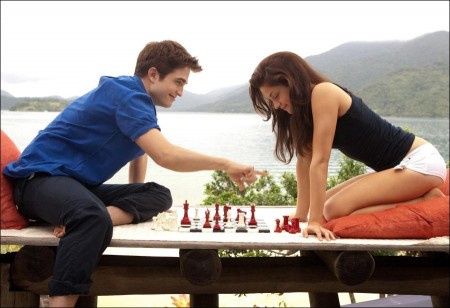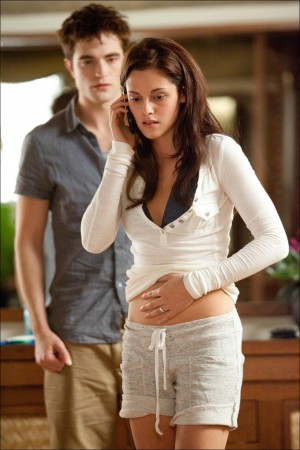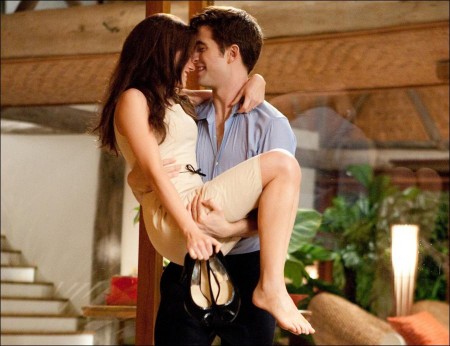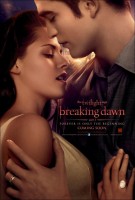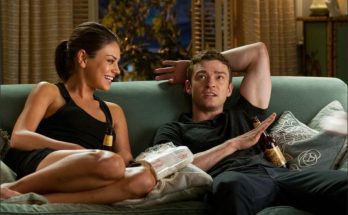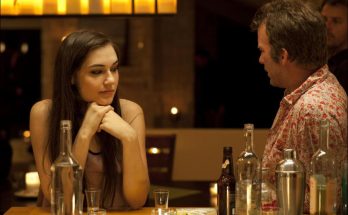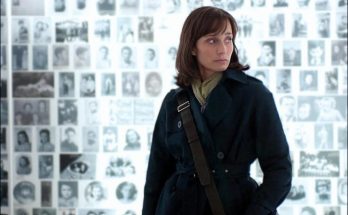Taglines: Forever is only the beginning.
In The Twilight Saga: Breaking Dawn – Part 1, Bella (Kristen Stewart) and Edward (Robert Pattinson), plus those they love, must deal with the chain of consequences brought on by a marriage, honeymoon, and the tumultuous birth of a child… which brings an unforeseen and shocking development for Jacob Black.
With more of the romance, passion, intrigue and action that made Twilight, The Twilight Saga: New Moon and The Twilight Saga: Eclipse worldwide blockbusters, The Twilight Saga: Breaking Dawn – Part 1, based on Stephenie Meyer’s bestselling book series, begins the conclusion of the tale of vampire love, boundless friendship, acceptance, and finding your true self.
The Final Chapter In The Phenomenon Begins
The Twilight Saga film series stars Kristen Stewart, Robert Pattinson, and Taylor Lautner and tells the story of 17-year-old Bella Swan who moves to the small town of Forks, Washington to live with her father, and becomes drawn to Edward Cullen, a pale, mysterious classmate who seems determined to push her away. But neither can deny the attraction that pulls them together…even when Edward confides that he and his family are vampires. To complicate matters, Bella’s best friend Jacob Black is a werewolf, designed solely to kill vampires.
The action-packed, modern day vampire love story Twilight, the first film in the series, was released in theatres on November 21, 2008 to a blockbuster reception. The second installment, The Twilight Saga: New Moon was released November 20, 2009, and the third film, The Twilight Saga: Eclipse, followed quickly on June 30, 2010. The three cinetime have grossed over $1.8 billion in worldwide ticket sales.
The films continue to set subsequent home entertainment records as well: The Twilight Saga: New Moon sold over 4 million DVD units in its first weekend of release in March of 2010 – a tally surpassing Twilight, which sold 3.8 million DVD units in its first weekend in 2009, and went on to be the top selling DVD title of the year with 9.2 million units sold. With each release, thousands of retail locations nationwide take part in midnight release events for insatiable Twilight fans, who are eager for more of the continuing story. With the home entertainment release of The Twilight Saga: Eclipse, the franchise has now sold more than 25 million DVD/Blu-ray units in the U.S. alone.
As in the book, The Twilight Saga: Breaking Dawn – Part 1 sees the three main characters continue on their journey into adulthood, beginning during the busy final days of preparations for the wedding of Bella and Edward. “At the end of Eclipse, we leave them in the meadow talking about the impending wedding. We begin Breaking Dawn with everyone that we’ve come to know receiving invitations. Bella and Edward are in different stages of night-before-the-wedding jitters, and then we embark right into the wedding of the century,” explains producer Wyck Godfrey, who has worked on all the films in the series. “Then we go off to Brazil, where they spend their honeymoon on Isle Esme and then problems occur, as they do in any marriage… in this case, an unexpected pregnancy. By the end of The Twilight Saga: Breaking Dawn – Part 1, Bella will no longer be single, will no longer be childless, and will no longer be human.”
With this installment, the saga explores more adult themes like marriage and family, and what you would do to protect those you love unconditionally. “I’ve always liked stories where the characters get to grow up. I didn’t like them when they were frozen in one period, where you have this person who’s always the same age and doing the same things,” explains series author Stephenie Meyer. “I loved Anne of Green Gables – that she grew up, got married, and had six kids. Then her kids grew up and got married… it feels like life. There’s progression. So I always intended to take the Twilight story through the generations. When I first got started, I loved what I was doing so much, it was such a beautiful creative release that I saw myself just going on through the generations and writing about them forever. I didn’t ever want to quit.”
Meyer adds, “Eclipse also ends with Jacob’s heartbreak and running off into the woods. Bella commits herself to Edward… he was always the answer for her. During all of the fun getting ready for the wedding in Breaking Dawn, Jacob doesn’t know exactly where he is. He runs north to Canada and just lives like a wolf for a couple of months. Jacob’s not gone for very long, because Bella and Edward are officially engaged in June, they get married August 13th and Jacob reappears at the wedding.”
Author Stephenie Meyer also takes on the role of producer for the final two installments of the film series, which were shot concurrently, and was on set on a daily basis throughout production. “It’s really been a constant natural progression in terms of Stephenie’s involvement, and our relationship has grown throughout the years. It’s gone from spot visits on Twilight, to steady visits on New Moon and Eclipse, and now she’s here full-time. I spend more time with Stephenie than I spend with my wife,” laughs Godfrey. “Our friendship is one that I cherish. The best thing about making cinetime is that it’s summer camp for adults. You make these fast, strong friendships with people that will be there for the rest of your life.”
“Actually the producing I’ve done on these two films, hasn’t been very different from what I’ve done on the past cinetime,” adds Meyer. “Really the producer title hasn’t changed my role much. All along, I’ve been very much a part of the decision making process, while also having to compromise. But, it is different having to worry so much about the weather and are we going to be able to shoot tomorrow. That’s a new experience.”
Godfrey agrees, “It’s not been dissimilar to the role she played on the other films. Whenever we have questions about mythology, whether she was physically there or not, we were calling and emailing her. She’s also looking at all the footage. Now she’s just here in the moment when ideas come up. Stephenie’s a good presence for the actors who sometimes have questions about their characters. Also, her knowledge of filmmaking has really expanded over these ew years. The last three cinetime have really been her film school.”
Meyer again served as a resource for screenwriter Melissa Rosenberg, a veteran of the entire film series. “Melissa has done an amazing job synthesizing these books into cinetime. From the very first book, she’s carried us all the way through, and had the discipline while we’re making one movie to really be buckling down on the next one, and forcing us to pay attention,” explains Godfrey. “I think that comes out of her experience in television keeping a show on track. Melissa really understands Stephenie’s world and has a great relationship with Stephenie. She knows how to articulate what she’s trying to do, and gets from Stephenie what is okay to lose and what to add. It’s a strong unified partnership.”
Since the novel Breaking Dawn, with sections told from both Bella and Jacob’s point-of-view, weighs in at a lengthy 754 pages, discussion began early in the process about splitting the dense story into two films. “When I read the book, that moment when Bella’s eyes pop open and they’re red, that just struck me,” states Rosenberg. “It was not so much an ‘ah ha moment’ as it was ‘well that’s obvious’ moment. I just felt it was a natural breaking point at the transition from Bella’s life as a human, to her life as a vampire and a parent. It’s just two different worlds for her.”
“Initially, I sat down and broke both stories into an outline. We had to know that it would work in an outline form, before we even moved forward. The book was very big, but not quite two cinetime. There needed to be some expansion. So, it was really incumbent upon me to make sure that there were two cinetime in there. The pressure was quite something,” laughs Rosenberg. The Twilight Saga: Breaking Dawn – Part 1 focuses on Bella creating her own family, and Part 2 is about protecting it. Rosenberg adds, “Part 1 is about leaving home. It’s about growing up and really becoming an adult, becoming a wife, becoming a mother and becoming powerful… really owning your own power. It is coming of age really, being on your own for the first time. It’s a very adult story, happening to an 18 year old. Part 1 ends with the moment Bella wakes up as a vampire, and Part 2 begins at exactly that same moment.”
“Initially, things seem ideal. It is the perfect romance finally coming together. But, as with all marriages, there are complications. There is no such thing as happy ever after,” warns Rosenberg. “Marriage is hard work, anyone who’s married will tell you that. So, of course, Bella and Edward have issues to work on, and they are life and death issues. They are really very, very high stakes, as high as they’ll ever be.”
Joining the ranks of previous Twilight Saga directors Catherine Hardwicke, Chris Weitz, and David Slade; Academy Award® winning filmmaker Bill Condon was selected to helm the last two installments.
“On Breaking Dawn, we were really blessed. A lot of great directors came forward who were interested in the material and the challenge of making two cinetime at once,” says Godfrey. “We had approached Bill Condon on one of the earlier cinetime so when we started looking for Breaking Dawn and he was both available and interested – that was a really exciting for all of us. I’ll always remember what he said in an early meeting talking about the books and the cinetime, ‘I guess I’ve imprinted on the world of Twilight.’ It was perfect that he’d used that metaphor for his own affection for the series.”
“What was interesting to me is that each of those previous films is very different, one to the other,” comments Condon. “Each director has had a completely different approach to those cinetime, even though the story is continuous from one book to the next. There’s a unity in the writing, both of the books and the scripts. But within those constraints, each director has done something very different. I was excited by that fact that the fourth movie especially, seemed really different from the others. And then, the fifth is very different from the fourth. So, it is a chance to put your mark on it.”
“The timing was never right before,” adds Condon. “But Breaking Dawn happened right on the heels of a movie that I was about to start making, falling apart. I got a call, read a rough outline, and then the novel. I was really turned on by it, partly because so much of the other cinetime have been the setup for what happens here. In the course of one movie, Bella gets married, she has sex for the first time, she gets pregnant, she gives birth, she dies, and she is reborn as a vampire. That’s just the first movie.”
“With all of the anticipation, the whole movie is a third act,” he adds. “It felt very satisfying, partly like an old Minnelli movie, like a great Hollywood romantic melodrama combined with a really cool intense horror movie. Both of those ideas clashing with each other, actually turning it into something that, I think, is unique. Also, I love vampire cinetime.”
At the end of the last film, Bella and Edward have a sword hanging over their heads in the expectation that, according to Volturi laws, she must be turned into a vampire. “The Volturi will be on screen en force in Part 2, but this ticking clock is there through all of Part 1. The Volturi are waiting,’” explains Godfrey.
“In this film, the main threat is not only the internal threat of the unknown child to Bella, but also the wolves’ pending attack on the Cullen house. We’ve stepped away from the threat of the Volturi, and really dealt and what the birth of this child is going to do to this uneasy truce between the Cullen vampires and the wolves,” adds Godfrey. “Bill’s perfect because he’s a genre junkie and he loves fantasy. Early in his career he also wrote genre films, plus he’s a visual director…. look at Dreamgirls.”
“There are classic Hollywood genres that go out of fashion, musicals are an example. I am interested in how you make those genres work,” Condon says. “As I said, this really is a classic romantic melodrama. Those really don’t get made much anymore. But across movie history, especially during the Golden Age of Hollywood, melodrama was really a staple genre, that’s now fallen by the wayside. So being able to work in that arena, and express a story through color, music, design, camera, and get inside this woman’s emotions, was exciting. You don’t get those opportunities very often.”
“I remember going in to talk to all the folks for the first time. Wow, there are big things to figure out here: sex for the first time, talking wolves, imprinting. There are big challenges in Part 1 alone, because it’s about taking something that’s written as a fantasy, and actually bringing the moviegoer along to the degree that they believe in it, and some of these ideas are pretty out there. How do we figure out how to create a universe where you would go along for that ride?”
“It was really great to have the security blanket of producer Wyck Godfrey and co-producer Bill Bannerman already on board. Wyck produced all the previous films and Bill joined the team on New Moon,” explains Condon. “First of all, the incredible knowledge… they’ve been down certain roads two and three times before. They have a very gentle way of steering you away from certain problems or dead ends. It was interesting to see them continue to be excited by the big challenges that each book presents.”
Condon, who won his Best Adapted Screenplay Oscar for Gods and Monsters – a film about the final days of the Frankenstein movie director – agreed with the decision to make the final chapter into two films. “It was pretty clear. This final book has three sections – the beginning and end are from Bella’s perspective, and the middle from Jacob’s point of view. Where it cuts off is the moment when she becomes a vampire, which is the point where we cut off the first movie. Up to then really is a full movie. A lot happens and the idea of doing all that in 50 minutes, would have forced us to just skim the surface of everything. It was the right thing to do.”
“The book shifts to Jacob’s perspective because at a certain point Bella becomes bedridden,” adds Meyer. “She can’t see what’s going on around her because she’s so sick. Bella’s out of touch, but the reader needs to see what’s going on and the actions outside the house. The narrative is away from Bella for the first time and I felt like it was time for someone else to tell the story. We get to see what’s going on with Jacob and how her decision is affecting the outside world. We get to see Edward away from her, and how torn up he is, which she doesn’t always get to see.”
Even though he is an accomplished screenwriter in his own right, Condon was happy to leave the screenwriting chores to Melissa Rosenberg. “We started from her outline. It was so good to have her, as she knew the challenges of adapting Twilight to the screen so intimately. Melissa is a really good writer and working with her was one of my favorite parts of making this movie. We would spend all this time batting it out. It was so thrilling not to have to do that writing work. Melissa is a woman, she knows this world and the voice of these characters so well. I really loved it because it was just a very easy, good collaboration.”
“It’s always a little bit dicey when a director is a writer/director. Plus, Bill Condon is an Academy Award® winning writer, whom I had always admired,” comments Rosenberg. “It could go one way or the other – either he does not really know how to talk to writers, he only knows how to do the writing himself, so he’ll just take the script. Or, he knows exactly how to communicate something to a writer and help the writer bring the material out. Bill is the latter. This was one of the best director collaborations I’ve ever had. He knew how to get to the heart of the story and he took it to levels that I had not found yet. After 20 years of screen writing, I really learned something from him, he really brought my game up. I’m a better writer because of Bill.”
“I’d already done three Twilight cinetime and I was getting tired. You rarely hear a writer say this, but part of me was hoping he might just take the script and do a polish. When we first sat down he says, ‘I don’t wanna write this – you’re going to write this.’ I was like ‘Oh, really?’ The one time I want a director to go on and re-write me, he refuses,” laughs Rosenberg. “But his notes were very specific, very inspiring, and very creative.”
“Bill and I began to work together by talking through the outlines, but then I went off and did the scripts. When we had done a couple drafts, that’s when the real work began. Conflict number one in the marriage is – Bella wants sex. She wants to have the full human experience and Edward is far too concerned for her safety. So they battle it out – she tries to seduce him and he tries to resist. As the book will tell you, she wins,” laughs Rosenberg. “For Bill, it was all about bringing out the emotion and rooting it in a very real universal human experience, and carrying theme through from the beginning to the end. That, of course, is all rooted in character. Bill and I went through every page, every line, every scene, and really worked those character moments.”
“Everyone is very, very intent on making sure that the cinetime don’t betray what those books are,” shares Condon. “That was very important to me, as it was to everybody on the film. So, it’s great to have Stephenie Meyer around to go and ask a question about what would this person do. It was mind blowing to have the author right there, handy and able to weigh in on things. Plus, she’s just a lot of fun to have around… she’s got a really wicked sense of humor, especially as you got into the very intense stuff. She’s a funny woman.”
Meyer also enjoyed the collaboration. “Working with Bill has been great. He is very easy to talk to and also very open with what he’s doing,” says Meyer. “I’ve never worked with a director who will let you see rough cuts, maybe because he knows how good it looks… he’s proud of it. He has such a feel for pulling the humanity out of the fantastic situation, which is what I really like to do. On that level, we connect. He was able to get some really beautiful things with Bella and Edward in that moment where she’s choosing to die and Edward’s reaction. I think the reason why the birth scene is so emotional is because Bill’s touching on that human reaction to the loss, rather than the human reaction to the gore. Bill has a real sensitive touch for that. Also, it’s been fun working on the wedding – he’s had some great ideas about music that are so romantic. I think it’s going to be really beautiful.”
“Bill’s talents are very obvious – he has pulled Academy Award® winning performances out of people that have never acted before,” adds Godfrey. “He’s helped his actors get many nominations, so he’s a great director of performance. Plus he’s won an Academy Award® for writing. He knows story, he knows character, and he is able to find the visual way to portray character. Kristen, Rob, Taylor, and everybody who have been in these cinetime for three years, are constantly looking for something more. You really want to grow as a character and as an actor, so to bring someone with Bill’s maturity and sophistication into the mix on these final two cinetime is, I think, a real blessing for them. He is able to articulate the sophisticated themes in Breaking Dawn. These are kids who haven’t gotten married, haven’t been pregnant, haven’t had children, and to have somebody who can guide them was really important.“
Condon was anxious to work with the young leads in this female-driven story. “The fact that the central character is a woman – who is played by Kristen Stewart – was a big turn on for me. I’ve been a big admirer of Kristen’s, based on the other cinetime plus a couple of other things I’d seen her do. To be able to be her partner as she took this incredible journey across these two cinetime was number one on my list of reasons to do the project,” comments Condon.
“Thank God for Bill Condon,” says Kristen Stewart, who has portrayed the main heroine Bella Swan throughout the film series. “You need someone who’s on top of the details, so you can lose your mind and just feel it. Working with every director is a unique experience, just as is every friendship you have in life.”
“Bill is not only one of the nicest people to be around but he’s an awesome director, which is good to have on this last one because this one was intimidating to say the least,” adds Stewart. “It’s pretty ambitious. It’s insane to be involved with one thing for so long, because you really do bottle up an energy to the point where it’s going to explode and you hope to God that you’re working with people that know how to catch it.”
Robert Pattinson, who completes the saga in his role as the vampire Edward Cullen, agrees. “Bill’s great. He has such a hard job. It’s been such an intense shoot for so long and he’s stayed calm, nice, and very pleasant throughout the whole thing. He’s extremely talented and cares a lot about the project.”
“Also, Bill’s got a very different story to work with and a lot of people could’ve balked at the subject matter, but he embraced it,” shares Pattinson. “He liked the horror aspects, which is quite bold for a series that’s known for its romantic aspects. That’s interesting because there’s no point in just emphasizing the bits which they’re known for – make it exciting and different. I really respect him for that. He has some great ideas for visuals. Some of the scenes, which would be impossible to show in a PG-13, he’s thought of very artful ways to do it, which are not too graphic, but strong images that stick with you.”
Returning as Jacob Black, Taylor Lautner adds, “Bill’s number one focus was on the characters. Breaking Dawn deals with so many that we were definitely going to need somebody that could handle it, not an easy job. The crazy thing is that, as the characters were growing up in the cinetime, we were as well. I was looking at pictures of us from Twilight and we looked so young. It was crazy. I was sixteen years old. It’s an awesome experience because we’ve been able to grow up together for the past three or four years.”
He continues, “Everybody has grown close to Bill. We have so much fun with him. Bill is incredible. I don’t even feel like I have to talk about his talent, because he’s just amazing. He’s proven that. The way we all connect to Bill is really hard to find and I’m very thankful we were able to have that in these two cinetime. We definitely couldn’t have done this without Bill.”
The young actors were also grateful for guidance available from author Stephenie Meyer. Lautner says, “I can’t thank her enough. She created these characters and having her here has been amazing because, let’s face it, this is probably the most confusing and complicated movie yet. She has all the answers and is actually a little prankster. She’s quite funny. Everybody’s grown pretty close to her.”
“I wish that she had been on the set every day for the first few cinetime,” states Stewart. “I’ve loved having her here so much. On a movie set, everything is very much about energy. Even if a beat is perfectly written and everybody knows what they want from it, if everyone’s not literally amp-ing up to that moment, you could be the greatest actor in the world and it’s going to fall flat. Basically having Stephenie on set is such a serious motivator and an inspiration. Not to say that I don’t have that with every actor and with Bill, but it’s just different with the writer. She literally bore it and you want to do her proud.”
Stewart continues, “She’s so willing to talk to me about anything. Sometimes you just have to say things again and again that you already know, just because two human beings standing next to each other that share the same idea, the energy literally just sparks. When you don’t have that, you go home crying that you ruined the scene. Even though it works in the movie, it’s just that you didn’t feel it. With Stephenie around, you feel it all the time.”
Meyer also has thoughts about the expectations of the fans, especially regarding the wedding of the century. “I’m hoping with Part 1, the fans will get a fantasy wedding that lives up to a romantic ideal for them. I hope that they really feel like Bella and Edward have the romantic connection they wanted to see, that that they feel like it got there for Bella – that she was able to mature in the way that she should and that she’s earned her happiness. I think that would be a nice feeling.”
The Twilight Saga: Breaking Dawn Part 1
Directed by: Bill Condon
Starring: Kristen Stewart, Robert Pattinson, Taylor Lautner, Ashley Greene, Anna Kendrick, Nikki Reed, Elizabeth Reaser, Kellan Lutz, Peter Facinelli
Screenplay by: Stephenie Meyer
Production Design by: Richard Sherman
Cinematography by: Guillermo Navarro
Film Editing by: Virginia Katz
Costume Design by: Michael Wilkinson
Set Decoration by: David Schlesinger
Art Direction by: Daniel Flaksman, Lorin Flemming, Nate Fredenburg, Troy Sizemore
Music by: Carter Burwell
MPAA Rating: PG-13 for disturbing images, violence, sexuality/partial nudity and some thematic elements.
Studio: Summit Entertainment
Release Date: November 18, 2011
View Twilight Saga Exclusive Website >>
Hits: 94
